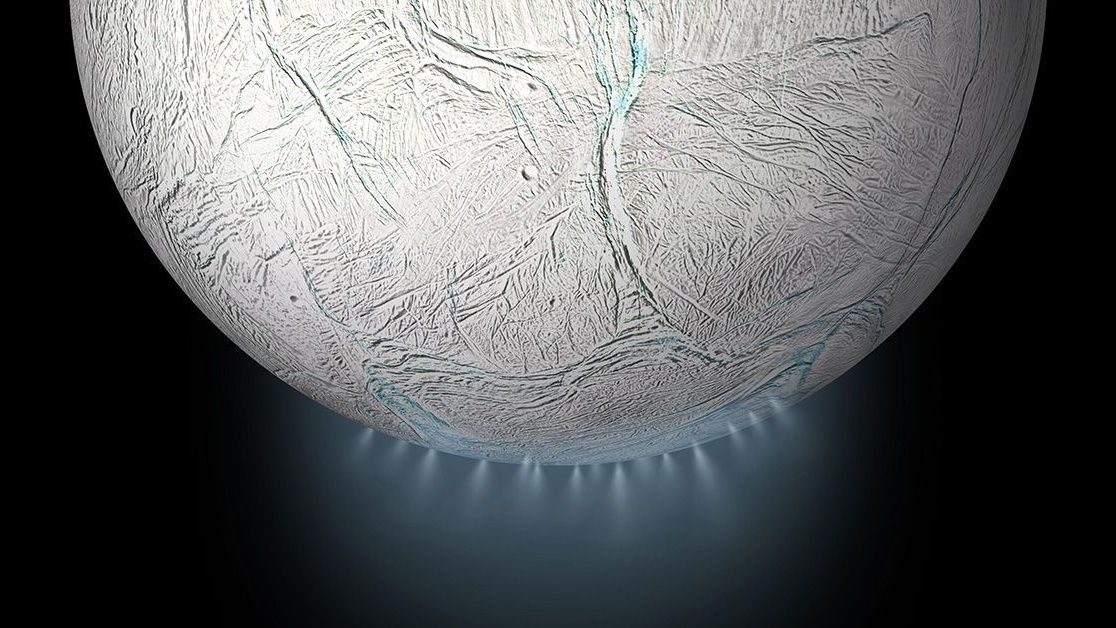Have you ever wondered if there is life beyond Earth? If so, you might be interested in Enceladus, one of the most fascinating and mysterious moons in our solar system. Enceladus is the sixth-largest moon of Saturn and, after Titan, one of the most-studied worlds in the system. It was discovered in 1789 by William Herschel and named after the Greek mythological giant Enceladus. But what makes Enceladus so special? Let’s find out.
Enceladus’ Unique Features
Enceladus has several features that make it a prime target for exploration and astrobiology. Some of these are:
- A global ocean of liquid water beneath its icy crust. Scientists have found evidence for a large south-polar subsurface ocean of liquid water with a thickness of around 10 km (6 mi). This ocean could be a possible habitat for life, as it may contain organic molecules, salts, and hydrothermal vents.
- Geysers that spray its ocean out into space. Enceladus has more than 100 geysers near its south pole that shoot jets of water vapor, molecular hydrogen, other volatiles, and solid material, including sodium chloride crystals and ice particles, into space, totaling about 200 kilograms (440 pounds) per second. These plumes are similar in composition to comets and supply most of the material making up Saturn’s E ring.
- A very reflective and diverse surface. Enceladus is the most reflective body in the solar system, with an albedo of 1.375 (meaning it reflects 137.5% of the sunlight that hits it). It is mostly covered by fresh, clean ice, but it also has regions of old, heavily cratered terrain and young, tectonically deformed terrain. The surface temperature varies from 32.9 K (−240 °C) to 145 K (−128 °C), depending on the location and time of day.
Enceladus’ Discoveries and Mysteries
Enceladus has been visited by several spacecraft, but the most detailed observations were made by NASA’s Cassini mission, which orbited Saturn from 2004 to 2017. Cassini performed 23 close flybys of Enceladus, revealing its surface and environment in greater detail. Some of the major discoveries made by Cassini include:
- The detection of water-rich plumes venting from the south polar region in 2005. This was the first indication of Enceladus’ subsurface ocean and geysers. Cassini sampled the plumes and found traces of organic compounds, ammonia, carbon dioxide, and other gases.
- The confirmation of a global ocean in 2014. Cassini measured the gravity and shape of Enceladus and found that it is slightly oblate (flattened at the poles) and has a positive mass anomaly at the south pole, indicating the presence of a large mass of liquid water under the ice.
- The discovery of molecular hydrogen in the plumes in 2017. Cassini detected molecular hydrogen (H2) in the plumes, which is a potential source of chemical energy for microbial life. The hydrogen is likely produced by hydrothermal reactions between water and rocks on the ocean floor.
However, Enceladus still has many mysteries that remain unsolved. For example, we don’t know:
- How old is Enceladus and how did it form? Some theories suggest that Enceladus formed from the accretion of icy particles in Saturn’s rings, while others propose that it was captured by Saturn’s gravity from the outer solar system. The age of Enceladus is also uncertain, as different regions of its surface show different degrees of cratering and tectonic activity.
- What is the exact composition and structure of Enceladus’ Ocean and core? We know that Enceladus’ Ocean is salty and contains organic molecules, but we don’t know the exact concentration and distribution of these substances. We also don’t know the size and composition of Enceladus’ core, which could be rocky, metallic, or a mixture of both.
- Is there life in Enceladus’ Ocean? This is the most intriguing and important question of all. We have some clues that Enceladus’ Ocean could be habitable, such as the presence of water, energy, and organic molecules, but we don’t have any direct evidence of life. To confirm the existence and nature of life in Enceladus’ Ocean, we need to send more advanced missions that can penetrate the ice and sample the water directly.
Enceladus’ Future Prospects
Enceladus is one of the most promising candidates for finding extraterrestrial life in our solar system. However, to explore it further, we need to overcome many challenges and limitations. Some of the proposed missions include:
- Enceladus Life Finder (ELF). This is a concept for a NASA mission that would fly through the plumes multiple times and analyze the organic molecules and biosignatures in them. It would also measure the isotopic ratios of carbon, hydrogen, nitrogen, and oxygen, which could indicate the origin and evolution of the ocean.
- Enceladus Explorer (En-Ex). This is a concept for a European Space Agency (ESA) mission that would land on the surface near the south pole and deploy a melt probe that would drill through the ice and reach the ocean. It would then release a mini-submarine that would explore the ocean and look for signs of life.
- Enceladus Orbilander. This is a concept for a joint NASA-ESA mission that would consist of an orbiter and a lander. The orbiter would map the surface and monitor the plumes, while the lander would touch down near the south pole and collect samples from the ice and the plumes.
Enceladus is a fascinating and mysterious world that awaits further exploration. It is a prime example of how diverse and surprising the solar system can be, and how much we still have to learn about it. Enceladus may hold the key to answering one of the most profound questions in science: are we alone in the universe?








